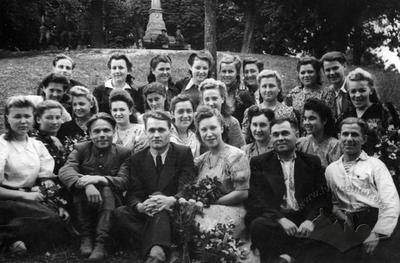Zolota Street green space (formerly Teofil Wiśniowski Park)
A small landscaped green space in northwest Lviv, on a hill overlooking the Krakivskyi Bazar, at the intersection of Zolota and Kleparivska Streets. Until the Second World War it was listed as a public city park. The historical name of the hill is “Execution Hill”. In 1847, Polish rebel-aristocrats Teofil Wiśniowski and Jόzef Kapuściński were executed here. In honor of their memory, in 1895 Lviv merchants erected a memorial obelisk on the hill and built a park around it with a design by the city’s leading landscape architect, Arnold Röhring.
Architecture
The former Wiśniowski Park occupies a plot of ground on Execution Hill (aka, Hytsleva or Dogcatcher Hill), a slight rise – 339m above sea level – considered part of Roztochia Hill and its significantly higher neighbor to the northwest, Kortumova Hill. The strip of land lies on an incline rising to the northwest. It is bordered on the east by Kleparivska Street, from the north by the curve of Zolota Street, and from the south by Pstrak Street. North of the park stands the former Veterans Home (currently the Lviv State University of Life Safety at 35 Kleparivska Street). The Krakivskyi Market stands across Kleparivska Street. To the south is the campus of the former Jewish hospital which runs adjacent to the territory of the razed Jewish cemetery. The center of the park square is marked by an obelisk raised in honor of Teofil Wiśniowski and Jόzef Kapuściński.
According to information dating from 1942 compiled by Olena Stepaniv, Wiśniowski Park “occupies a portion of Execution Hill along Kleparivska Street. This is a tiny green slice on a rolling plot of land. Maple, chestnut, ash, larch and other trees grow here” (Stepaniv, 1992, p47). In the early 1920s Mieczysław Orłowicz recorded that the park covered 2.8 hectares (Orłowicz, 1925, p168). Currently the green space on the corner between Zolota and Kleparivska Streets – once the city’s smallest park – is in a state of disrepair.
Personalities
Teofil Wiśniowski – Polish rebel
Jόzef Kapuściński – Polish rebel
Ivan Krypiakevych – historian
Julian Markowski – sculptor
Michał Michalski – civic activist, Lviv President
Mieczysław Orłowicz – ethnographer, guidebook
author
Arnold Röhring – landscape architect, park designer
Olena Stepaniv – historian, geographer, civic activist
Sources
- Barański, F. Przewodnik po Lwowie: Z planem i widokami Lwowa. Lwów: 1902.
- Krypyakevych, Ivan. Historical Walks Around Lviv. Lviv: Kamenyar, 1991.
- Miasto Lwów w okresie samorządu 1870-1895. Lwów: 1896.
- Orłowicz, M. Ilustrowany przewodnik po Lwowie: Ze 102 ilustracjami i planem miasta. Wydanie drugie rozszerzone. Lwów – Warszawa: Książnica-Atlas, 1925.
- Stankiewicz, Z. „Ogrody i plantacje miejskie”. Lwów dawny i dzisiejszy: Praca zbiorowa pod redakcja B. Janusza.Lwów: 1928, p. 62–71.
- Stepaniv, Olena. Contemporary Lviv: A Guidebook. Lviv: Phoenix, 1992.
Material compiled by: Ihor Zhuk, december 2012
Media Archive Materials
Related Pictures







